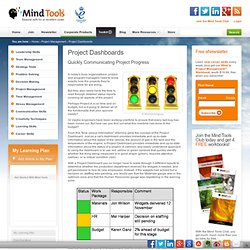

Minimum Viable Product: a guide. One of the most important lean startup techniques is called the minimum viable product.

Its power is matched only by the amount of confusion that it causes, because it's actually quite hard to do. It certainly took me many years to make sense of it. I was delighted to be asked to give a brief talk about the MVP at the inaugural meetup of the lean startup circle here in San Francisco. Below you'll find the video of my remarks as well as the full slides embedded below. But I wanted to say a few words first. First, a definition: the minimum viable product is that version of a new product which allows a team to collect the maximum amount of validated learning about customers with the least effort. Some caveats right off the bat.
Second, the definition's use of the words maximum and minimum means it is decidedly not formulaic. Without further ado, the video: Slides are below: Project Dashboards - Project Management Tools from MindTools. Quickly Communicating Project Progress © iStockphoto/jgroup In today's busy organizations, project and program managers need to know exactly how the projects they're responsible for are doing.

But they also rarely have the time to read through detailed status reports covering all aspects of the project. Perhaps Project A is on time and on budget, but is it going to deliver all of the functionality that your sponsor needs? Or maybe engineers have been working overtime to ensure that every last bug has been ironed out. From this "time versus information" dilemma grew the concept of the Project Dashboard. With a Project Dashboard you no longer have to wade through 3 different reports to determine whether the production department received the widgets it needed, and got permission to hire its new employees. With the overall simplicity of a dashboard, you need to remember that dashboards are not, in and of themselves, a panacea. Tip 1: Tip 2: If you're a client, beware false positives. Project Initiation Documents - Project Management Tools from MindTools.
Getting Your Project Off to a Great Start © iStockphoto/kzenon Have you ever been part of a project where not everyone has the same view of where the project is heading?

This lack of clarity can breed confusion: People start pulling in different directions, building up unrealistic expectations, and harboring unnecessary worries and fears. While it's normal as part of a project to put the detailed plans, controls and reporting mechanisms into place, how do you get everyone on the same page to start with? This is accomplished by creating a Project Initiation Document (PID) – the top-level project planning document.
Your Project Initiation Document does the following: Defines your project and its scope.Justifies your project.Secures funding for the project, if necessary.Defines the roles and responsibilities of project participants.Gives people the information they need to be productive and effective right from the start. By creating a PID, you'll answer the questions: What? Tip: Note: Background. Project Initiation Documents - Project Management Tools from MindTools. Organization Design - Project Management Tools from MindTools. Aligning Organizational Structure With Business Goals Does your organization's design actually work?

© iStockphoto/vm Is your organization well-designed? And how do you know? What does a well-designed organization look like, and how does it feel to work there? These are the types of questions we will explore in looking at organization design. Many people equate organization design with an organization's structure: The words "lean" and "flat" are used to describe organization design as well as it's structure. Good organizational design helps communications, productivity, and innovation. Many productivity and performance issues can be traced back to poor organization design. Take the example of a company whose sales department and production department both work well as separate units. How work is done, business processes, information sharing and how people are incentivized; all of these directly affects how well the organization performs.
Types of Organization Structure. Organization Design - Project Management Tools from MindTools.